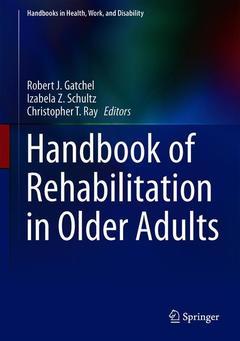Handbook of Rehabilitation in Older Adults, 1st ed. 2018 Handbooks in Health, Work, and Disability Series
Coordonnateurs : Gatchel Robert J., Schultz Izabela Z., Ray Christopher T.

Dr. Robert Gatchel is the Nancy P. & John G. Penson Endowed Professor of Clinical Health Psychology and the chairman of the department of psychology, College of Science at the University of Texas at Arlington. He also holds two other positions: clinical research director at the Eugene McDermott Center for Pain Management at the University of Southwestern Medical Center at Dallas, and director of biopsychosocial research at the University of North Texas Health Science Center. He received a prestigious Research Scientist Award from NIH and has been honored with awards from various organizations such as the American Psychological Association, the American Pain Society, the American Academy of Pain Management, the International Association for Dental Research, the International Society for the Study of the Lumbar Spine, the North American Spine Society, to name a few.
Dr. Izabela Z. Schultz is Professor of Rehabilitation Psychology and Director of Graduate Program in Vocational Rehabilitation Counseling in the Department of Educational and Counseling and Special Education at the University of British Columbia. Dr. Schultz is doubly board certified as diplomate in clinical psychology, American Board of Professional Psychology and as diplomate of the American Board of Vocational Experts. She has received international awards for her innovative research on prediction of occupational disability and professional leadership awards for major contributions to medico-legal aspects of rehabilitation psychology. She has been leading development of best-evidence-informed practice guidelines in early musculoskeletal pain interventions, in work accommodation and retention in mental health, and in assessment and treatment of persons with disabilities.
Dr. Christopher Ray is the founding director of the Center for Healthy Living and Longevity at the University of Texas Arlington and the associate dean of research for the College of Nursing and Health Innovation. Dr. Ray
Provides a comprehensive source for understanding chronic illnesses and their rehabilitation in older adults
Reviews biopsychosocial rehabilitation approaches to reduce the degree of disability in older adults
Discusses work-related factors to maintain work engagement in older workers
Date de parution : 03-2019
Ouvrage de 583 p.
17.8x25.4 cm
Thèmes de Handbook of Rehabilitation in Older Adults :
Mots-clés :
rehabilitation of older adults; disability in older adults; graying of the West and America; predictors of longevity and QOL in older adults; preventing slips and falls in older adults; musculorskeletal pain and disability in older adults; aging with spinal cord injury; aging with chronic disabling condition; aging with Parkinson's disease; cancer survivorship in older adults; managing cancer in older adults; mental health disorders in older adults; gait and balance control training; interdisciplinary pain and disability programs for older adults; cardiovascular rehabilitation for older adults; brain injury rehabilitation for older adults; medication management for older adults; competency assessment for older adults; prolonging independence in older adults; health and wellness programs for older adults
